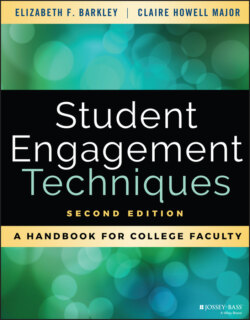Читать книгу Student Engagement Techniques - Elizabeth F. Barkley - Страница 58
Authentic Assessment
ОглавлениеAn additional element stressed by Wiggins and others is authentic assessment, an approach to assessment that developed out of the concern that conventional assessment instruments tend to focus on the more superficial and easily tested aspects of knowledge and do not replicate the kinds of challenges that adults face in the workplace, civic affairs, or in their personal lives. Authentic assessment aims to be realistic, which means the task(s) reproduce the ways and the contexts in which a person's knowledge and abilities are “tested” in real-world situations. This typically involves the student “doing” the subject. Instead of reciting, restating, or replicating through demonstration what he or she was taught or what is already known, the student has to carry out the kind of exploration and work that constitutes “doing” the discipline.
Second, authentic assessment requires judgment, innovation, and efficient and effective use of a repertoire of knowledge and skills to negotiate a complex task or solve complex problems. In other words, rather than consisting of isolated elements of performance, authentic assessment requires students to integrate multiple elements. Third, authentic assessment focuses on being formative, allowing appropriate opportunities to rehearse, practice, consult resources, and get feedback on and refine performances and products (Wiggins, 1998, pp. 23–24). What constitutes an “authentic assessment task” is discipline and course-specific, but for example in a history course, rather than testing whether a student can remember the facts of history, an authentic assessment task might ask students to research a controversial historical account to determine the facts. Because authentic assessment tasks seem more relevant and also tend to be more interesting, students are often more motivated to do them than they are to do conventional assessment activities. Additionally, because of their greater complexity, they can allow for a range of responses that can encourage students to work within their optimal challenge zone.
There are many different ways to approach assessment, but to be effective in improving teaching and learning, assessment strategies involve the same basic steps: (1) identify a learning goal; (2) select an assessment technique that will measure to what extent the goal has been achieved; (3) apply the assessment technique; (4) analyze the results of the assessment and share the results with the student(s), ideally providing an opportunity for student feedback; and (5) respond to the results and implement any necessary change in teaching strategy or course content (Fenton & Watkins, 2008, pp. 6–7). In our 2016 book on learning assessment, we similarly suggest that assessment should involve:
1 Identifying significant learning goals
2 Implementing effective learning activities
3 Analyzing and reporting upon outcomes
